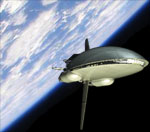
Fleets
An empire exerts influence mostly by the use of its imperial starfleet. If a world is in danger of being attacked, a fleet is deployed to the planet as protection. If rebellion seems imminent, imperial troops are dispatched to the site of unrest. If expansion is desired, a fully configured battle fleet is sent to subdue a bordering independent world. An empire often resolves conflicts with force, and force is always exerted with an imperial fleet.
Because there are many different kinds of ships, fleets can be categorized by the types of ships that comprise them. For example, hunter-killers, jumpships, and jumptransports are equipped with jumpdrives—propulsion systems that enable them to travel up to ten sectors in one year. A fleet composed only of these three kinds of ships will be able to take advantage of this capability, but any fleet that mixes jumpship and warp ships will have to travel at the speed of the slowest ships, i.e., one sector per year.
The following sections detail the capability of various kinds of fleets.
Movement
As mentioned previously, fleets composed of hunter-killers, jumpships, and jumptransports can travel up to ten sectors per year. Penetrators can move two sectors per year and a fleet of penetrators can move at that rate as long as no other ship in the fleet moves more slowly (for example, a fleet of penetrators and jumpships can move up to two sectors per year). Any fleet that includes transports, fighters, or starships cannot move faster than one sector per year.
Initiative
Fleets move at different times depending on the nature of their drives. Jumpspace fleets (composed of hunter-killers, jumpships, and jumptransports) always move at the end of an empire's turn and thus lose the initiate to the enemy. An enemy empire will always be able to respond to a jumpfleet at its destination before the controlling empire. Conversely, warp fleets move at the beginning of an empire's turn and thus gain the initiative.
This property of fleets creates some interesting possibilities. Suppose, for instance, that an empire has decided to blockade one of its enemy's worlds with a large fleet. Any warp fleet that the second empire deploys from the blockaded world may easily be destroyed by the large fleet. On the other hand, jumpfleets from the same world may leave freely. On the reverse side, warp fleets may enter and land on the world easily, but jumpfleets entering the sector are vulnerable to attack.
Detection and Scanning
An enemy fleet will be detected if it approaches near any unit of the empire. The distance at which the detection occurs depends on the type of fleet and the nature of the unit doing the detection. If an enemy fleet is detected it will appear on the map as a red fleet icon.
At certain distances, an enemy fleet can be scanned by a unit of the empire. Again, the range at which a scan is possible depends on the type of fleet and the nature of the unit doing the scanning. Scanning reveals the composition and course of an enemy fleet.
Worlds can detect any enemy fleet within five sectors unless the fleet is composed of only hunter-killers or penetrators, or unless the fleet is inside a nebula. Worlds can detect and scan any enemy fleet within one sector unless the fleet is composed solely of hunter-killers.
Starbases such as outposts, fortresses, and command bases can detect and scan an enemy fleet of any composition within five sectors.
Fleets can detect and scan any enemy fleet within one sector unless the fleet is composed solely of hunter-killers.
Transports
Of course, military missions are not the only uses for fleets. Transport fleets are invaluable to an empire, particularly if many worlds are not self-sufficient or addicted to ambrosia. Any fleet with transports or jumptransports can carry materials and infantry from one world to another. Each transport can carry three megatons or chemicals or metals, two megatons of supplies, one hundred kilotons of trillum or ambrosia, or five infantry legions. Jumptransports can carry one fifth of this amount.
Fuel
All fleets need trillum as fuel to power their main drives. Fleets automatically fill their reservoirs with fuel when deployed. Each year of movement uses up some of the fleet's fuel. Before fuel runs out, the emperor or empress must order the fleet to refuel from a world or another fleet in the same system. Fleets that carry trillum in transports or jumptransports automatically refuel themselves if they run out.
Next: Combat
